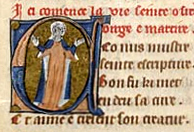Osyth
| Osgyth | |
|---|---|

An illuminated capital commencing the anonymous "La Vie seinte Osith, virge e martire" (Campsey Manuscript, British Library Additional Ms 70513, fol. 134v)
|
|
| Born | Quarrendon, Buckinghamshire |
| Died | 700 AD |
| Venerated in |
Anglican Communion Roman Catholic Church |
| Feast | 7 October |
| Attributes | Depicted carrying her own head |
| Controversy | Popularly considered a saint in England, but possibly not formally canonized |
| Osgyth | |
|---|---|
| Queen consort of Essex | |
| Born | Quarrendon, Buckinghamshire, Mercia |
| Died | 700 |
| Spouse | Sighere of Essex |
| Issue | Son |
| Father | Frithuwold of Surrey |
| Mother | Wilburga |
| Religion | Christianity |
Osgyth (or Osyth) (died c.700 AD) was an English saint. She is primarily commemorated in the village of Saint Osyth, Essex, near Colchester. Alternative spellings of her name include Sythe, Othith and Ositha.
Born in Quarrendon, Buckinghamshire (at that time part of Mercia), she was the daughter of Frithwald, a sub-king of Mercia in Surrey, and was the niece of St Edith of Aylesbury and Saint Edburga of Bicester. Her mother was Wilburga, the daughter of the pagan King Penda of Mercia.
Raised in a convent in Warwickshire under the direction of Saint Modwen her ambition was to become an abbess, but she was too important as a dynastic pawn to be set aside.
Forced by her father into a dynastic marriage with Sighere, King of Essex, she did her dynastic duty and produced him a son. While her husband ran off to hunt down a beautiful white stag, Osgyth persuaded two local bishops to accept her vows as a nun. Then, eventually, perhaps after Sighere's death, she established a convent at Chich, in Essex, where she ruled as first abbess.
Her death was accounted a martyrdom by some, but Bede makes no mention of Saint Osgyth. The 13th-century chronicler Matthew Paris repeats some of the legend that had accrued around her name. The site of her martyrdom became transferred to the holy spring at Quarrendon. The holy spring at Quarrendon, mentioned in the time of Osgyth's aunts, now became associated with her legend, in which Osgyth stood up after her execution, picking up her head like Saint Denis in Paris, and other cephalophoric martyrs and walking with it in her hands, to the door of a local convent, before collapsing there. Some modern authors link the legends of cephalophores miraculously walking with their heads in their hands to the Celtic cult of heads.
...
Wikipedia
